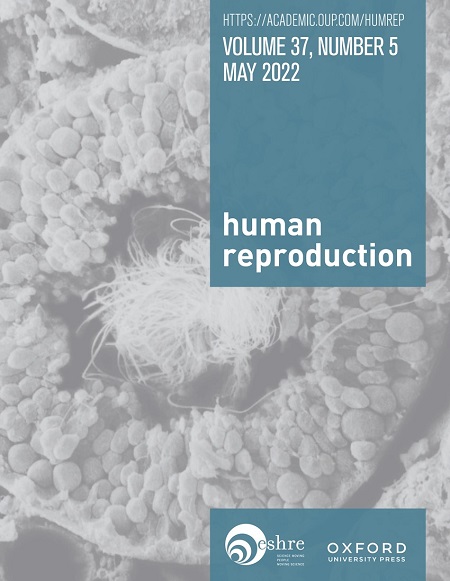Preterm birth in assisted reproduction: the mediating role of hypertensive disorders in pregnancy
IF 6
1区 医学
Q1 OBSTETRICS & GYNECOLOGY
引用次数: 0
Abstract
STUDY QUESTION To what extent can hypertensive disorders in pregnancy (HDP) explain the higher risk of preterm birth following frozen embryo transfer (frozen-ET) and fresh embryo transfer (fresh-ET) in ART compared with naturally conceived pregnancies? SUMMARY ANSWER HDP did not contribute to the higher risk of preterm birth in pregnancies after fresh-ET but mediated 20.7% of the association between frozen-ET and preterm birth. WHAT IS KNOWN ALREADY Risk of preterm birth is higher after ART compared to natural conception. However, there is also a higher risk of HDP in pregnancies after ART compared to natural conception, in particular after frozen-ET. HDP increases the risk of both spontaneous and medically indicated preterm birth. It is not known to what extent the higher risk of preterm birth in ART-conceived pregnancies is mediated through HDP. STUDY DESIGN, SIZE, DURATION This registry-based cohort study included singleton pregnancies from the Committee of Nordic ART and Safety (CoNARTaS) cohort from Denmark (1994–2014), Norway (1988–2015), and Sweden (1988–2015). The analysis included 78 300 singletons born after fresh-ET, 18 037 after frozen-ET, and 4 426 682 after natural conception. The exposure was ART conception with either frozen-ET or fresh-ET versus natural conception. The main mediator of interest was any of the following HDP: gestational hypertension, preeclampsia, eclampsia, or chronic hypertension with superimposed preeclampsia. The main outcome was any preterm birth, defined as delivery <37 weeks of gestation. Secondary outcomes were spontaneous and medically indicated preterm birth, and different severities of preterm birth based on the gestational age threshold. PARTICIPANTS/MATERIALS, SETTING, METHODS We linked data from the national Medical Birth Registries, ART registries/databases, and the National Patient Registries in each country using the unique national identity number of the mother. Criteria for inclusion were singleton pregnancies with birth order 1–4 in women aged ≥20 years at delivery. We used logistic regression to estimate odds ratios (ORs) with 95% CIs of preterm birth and decomposed the total effect into direct and mediated (indirect) effects to estimate the proportion mediated by HDP. Main models included adjustment for the year of delivery, maternal age, parity, and country. MAIN RESULTS AND THE ROLE OF CHANCE Pregnancies following frozen-ET had a higher risk of any preterm birth compared to natural conception (occurrence 6.6% vs 5.0%, total effect OR 1.29, 95% CI 1.21–1.37) and 20.7% of the association was mediated by HDP (mediated effect OR 1.05, 95% CI 1.04–1.05). The mediation occurred primarily in medically indicated preterm births. Pregnancies following fresh-ET also had a higher risk of any preterm birth compared to naturally conceived pregnancies (occurrence 8.1% vs 5.0%, total effect OR 1.49, 95% CI: 1.45–1.53), but none of this could be mediated by HDP (mediated effect OR 1.00, 95%CI 1.00–1.00, proportion mediated 0.5%). Sensitivity analyses with extra confounder adjustment for body mass index and smoking, and restriction to primiparous women, were consistent with our main findings. Furthermore, the results were not driven by differences in ART procedures (intracytoplasmic sperm injection, culture duration, or the number of embryos transferred). LIMITATIONS, REASONS FOR CAUTION Although we could adjust for some important confounders, we cannot exclude residual confounding, particularly from factors associated with infertility. WIDER IMPLICATIONS OF THE FINDINGS This population-based mediation analysis suggests that some of the higher risk of preterm birth after ART treatment may be explained by the higher risk of HDP after frozen-ET. If causality is established, investigations into preventive strategies such as prophylactic aspirin in pregnancies after frozen-ET may be warranted. STUDY FUNDING/COMPETING INTEREST(S) Funding was provided by NordForsk (project number: 71450), the Nordic Federation of Obstetrics and Gynaecology (project numbers NF13041, NF15058, NF16026, and NF17043), the Norwegian University of Science and Technology (project number 81850092), an ESHRE Grant for research in reproductive medicine (grant number 2022-2), and the Research Council of Norway’s Centres of Excellence funding scheme (project number 262700). D.A.L.’s and A.E.’s contribution to this work was supported by the European Research Council under the European Union’s Horizon 2020 research and innovation program (grant agreements No 101021566) and the UK Medical Research Council (MC_UU_00032/05). D.A.L. has received support from Roche Diagnostics and Medtronic Ltd for research unrelated to that presented here. Pinborg declares grants from Gedeon Richter, Ferring, Cryos, and Merck, consulting fees from IBSA, Ferring, Gedeon Richter, Cryos, and Merck, payments from Gedeon Richter, Ferring, Merck, and Organon,travel support from Gedeon Richter. All other authors declare no conflicts of interest related to this work. TRIAL REGISTRATION NUMBER ISRCTN 35879.辅助生殖中的早产:高血压疾病在妊娠中的中介作用
研究问题:妊娠期高血压疾病(HDP)在多大程度上可以解释ART中冷冻胚胎移植(frozen- et)和新鲜胚胎移植(fresh- et)后早产风险高于自然妊娠的原因?HDP与新鲜et后妊娠的早产风险无关,但在冷冻et与早产之间介导了20.7%的关联。与自然受孕相比,人工受精后早产的风险更高。然而,与自然受孕相比,抗逆转录病毒治疗后怀孕发生HDP的风险也更高,尤其是冷冻体外受精后。HDP增加了自发早产和医学指示性早产的风险。目前尚不清楚HDP在多大程度上介导了art妊娠中较高的早产风险。这项基于登记的队列研究包括来自北欧艺术与安全委员会(CoNARTaS)丹麦(1994-2014)、挪威(1988-2015)和瑞典(1988-2015)的单胎妊娠。分析包括78 300例新鲜et后出生的单胎,18 037例冷冻et后出生的单胎,以及4 426 682例自然受孕后出生的单胎。暴露是ART受孕,冷冻et或新鲜et与自然受孕。主要感兴趣的中介是以下任何一种HDP:妊娠期高血压、子痫前期、子痫或慢性高血压合并子痫前期。主要结果是早产,定义为妊娠37周。次要结局是自发性早产和医学指示性早产,以及基于胎龄阈值的不同严重程度的早产。参与者/材料、环境、方法我们使用母亲的唯一国家身份号码将每个国家的国家医学出生登记处、ART登记处/数据库和国家患者登记处的数据联系起来。纳入标准为分娩时年龄≥20岁、出生顺序为1-4的单胎妊娠。我们使用逻辑回归来估计早产95% ci的优势比(or),并将总效应分解为直接效应和介导(间接)效应来估计HDP介导的比例。主要模型包括根据分娩年份、产妇年龄、胎次和国家进行调整。与自然受孕相比,冷冻体外受精后的偶发妊娠有更高的早产风险(发生率6.6% vs 5.0%,总效应OR 1.29, 95% CI 1.21-1.37), 20.7%的关联是由HDP介导的(介导效应OR 1.05, 95% CI 1.04-1.05)。这种调解主要发生在医学上指征的早产中。与自然妊娠相比,新鲜et妊娠也有更高的早产风险(发生率8.1% vs 5.0%,总效应OR 1.49, 95%CI: 1.45-1.53),但这些都不能由HDP介导(介导效应OR 1.00, 95%CI 1.00 - 1.00,比例介导0.5%)。敏感性分析加上额外的混杂因素调整,如体重指数和吸烟,以及对初产妇女的限制,与我们的主要发现一致。此外,结果不是由ART程序的差异(卵胞浆内单精子注射,培养时间或转移的胚胎数量)驱动的。虽然我们可以调整一些重要的混杂因素,但我们不能排除残留的混杂因素,特别是与不孕症相关的因素。这项以人群为基础的中介分析表明,ART治疗后早产风险较高的部分原因可能是冷冻et治疗后HDP风险较高。如果建立了因果关系,可能需要对冷冻et后怀孕的预防性策略进行调查,如预防性阿司匹林。研究资金/竞争利益(S)资金由NordForsk(项目编号:71450)、北欧妇产科联合会(项目编号:NF13041、NF15058、NF16026和NF17043)、挪威科技大学(项目编号:81850092)、ESHRE生殖医学研究补助金(赠款编号:2022-2)和挪威卓越中心资助计划研究理事会(项目编号:262700)提供。D.A.L和a.e.对这项工作的贡献得到了欧洲研究理事会在欧盟地平线2020研究和创新计划(资助协议号101021566)和英国医学研究理事会(MC_UU_00032/05)下的支持。D.A.L.已经得到罗氏诊断公司和美敦力有限公司的支持,用于与这里介绍的研究无关的研究。Pinborg宣布了Gedeon Richter、Ferring、Cryos和Merck的资助,IBSA、Ferring、Gedeon Richter、Cryos和Merck的咨询费,Gedeon Richter、Ferring、Merck和Organon的付款,Gedeon Richter的旅行支持。
本文章由计算机程序翻译,如有差异,请以英文原文为准。
求助全文
约1分钟内获得全文
求助全文
来源期刊

Human reproduction
医学-妇产科学
CiteScore
10.90
自引率
6.60%
发文量
1369
审稿时长
1 months
期刊介绍:
Human Reproduction features full-length, peer-reviewed papers reporting original research, concise clinical case reports, as well as opinions and debates on topical issues.
Papers published cover the clinical science and medical aspects of reproductive physiology, pathology and endocrinology; including andrology, gonad function, gametogenesis, fertilization, embryo development, implantation, early pregnancy, genetics, genetic diagnosis, oncology, infectious disease, surgery, contraception, infertility treatment, psychology, ethics and social issues.
 求助内容:
求助内容: 应助结果提醒方式:
应助结果提醒方式:


